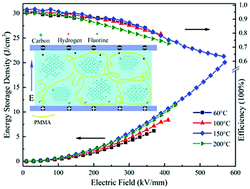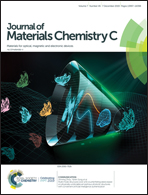A blended binary composite of poly(vinylidene fluoride) and poly(methyl methacrylate) exhibiting excellent energy storage performances†
Abstract
Polymer-based dielectric composites have become a hot topic in recent years due to their high-power density and high breakdown strength. However, some disadvantages still exist in some typical monopolymers, which are not conductive to improving the energy storage performances significantly, such as high energy loss of PVDF and low polarization of PMMA. Based on the good compatibility of PMMA and PVDF, this paper proposes a binary polymer blending strategy to improve the polarization and energy storage properties of the dielectric composite. The influences of volume content of PMMA in PVDF and heat treatment temperature during the fabrication process on the microstructure, polarization behaviors and energy storage performances of the PMMA blended PVDF composites (abbreviated as PMMA/PVDF) are systematically investigated. Fortunately, when the heat treatment temperature was 150 °C, the binary blending composite of PMMA/PVDF with a PMMA content of 50 vol% possessed an excellent storage density of 20.1 J cm−3 at 570 kV mm−1, and an energy storage efficiency of 63.5%. This study provides an effective method for designing polymer materials with excellent energy storage properties.



 Please wait while we load your content...
Please wait while we load your content...